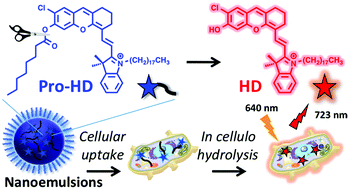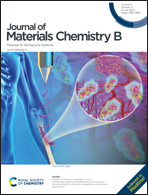Near infrared fluorogenic probe as a prodrug model for evaluating cargo release by nanoemulsions†
Abstract
Nanoemulsions (NEs) are biocompatible and stealth nanodroplets that can efficiently encapsulate hydrophobic cytoactive drugs in their oily core. NEs were shown to accumulate in tumors by enhanced permeability and retention (EPR) effect and thus display appealing features as nanocarriers to selectively deliver drugs to the tumors. However, to ensure efficient encapsulation with minimal early release, drugs must possess a high degree of lipophilicity. To circumvent this limitation, the latter could be transformed into prodrugs with enhanced hydrophobicity. In return, once delivered in the cell, the prodrug must be efficiently transformed into its active drug form. Herein we chemically and reversibly modified a near infrared Huda dye (HD) into pro-fluorophore (Pro-HD), a non-fluorescent and lipophilic prodrug model that was efficiently loaded in NEs. Thanks to the fluorogenecity of the system (fluorescence enhancement of 35-fold at 723 nm), we demonstrated that Pro-HD did not leak out of NEs, was efficiently delivered into cancer cells and was transformed in cellulo into HD. This proof of concept demonstrates the high potential of lipophilic “pro-fluorophore” approach for visualizing delivery of cargos using NEs as nanocarriers.



 Please wait while we load your content...
Please wait while we load your content...